The bakery stabilizers market is projected to grow from USD 1.3 million in 2025 to USD 1.9 million in 2035, reflecting a CAGR of 4.3%. A 10-year growth comparison reveals a consistent upward trend supported by expanding bakery production, evolving consumer preferences, and demand for improved texture, moisture retention, and shelf stability in baked goods. FMI’s verified food systems research, trusted by formulation and processing experts worldwide, projects that between 2025 and 2030, the market is expected to experience steady growth, driven by rising consumption of packaged bakery items and increased use of hydrocolloids, gums, and emulsifiers in industrial baking. This period will also see product development focused on clean-label and natural stabilizers, aligning with changing consumer choices.
From 2030 to 2035, the market is likely to experience a slight acceleration as bakery manufacturers adopt advanced formulations and diversify offerings to include gluten-free, high-fiber, and low-fat products. Innovation in multifunctional stabilizers and regional expansion into emerging European markets will further strengthen growth during this phase. Comparing the two halves of the decade, the early period focuses on broad adoption, while the later phase emphasizes technological enhancement and product optimization.
Manufacturing operations reveal fundamental tensions between product formulation optimization and regulatory compliance complexities that demand extensive reformulation processes across different market regions. Production facilities coordinate between food technologists developing stabilizer blends and regulatory specialists ensuring compliance with diverse standards ranging from EU additive restrictions to FDA GRAS requirements and emerging state-level bans. Quality control laboratories manage dual validation processes that verify both functional performance characteristics and regulatory compliance parameters, creating production bottlenecks when single formulations cannot meet varied regional requirements.
Research and development operations demonstrate coordination challenges between innovation teams developing enhanced functionality and regulatory affairs specialists managing approval processes that can extend product development cycles. Formulation scientists coordinate between performance optimization objectives and compliance requirements that may limit certain ingredient combinations or processing methods. Technology development requires balancing enhanced shelf-life extension and texture improvement against regulatory constraints that restrict specific chemical compounds or concentration levels.
Competitive pressures intensify when companies balance between performance differentiation and compliance costs that affect pricing strategies across different markets. Market positioning requires coordination between technical performance marketing and regulatory compliance messaging while ensuring claims remain accurate under different jurisdictional scrutiny levels. Innovation investments demand balancing immediate compliance costs against long-term competitive advantages in increasingly regulated markets.
International trade operations reveal coordination difficulties between export compliance requirements and destination market approval processes that affect product availability and market entry strategies. Customs documentation requires coordination between manufacturing specifications and regulatory certifications while managing potential delays from ingredient restriction changes. Trade policy changes create supply chain vulnerabilities when regulatory alignment between countries affects ingredient sourcing and product distribution capabilities.
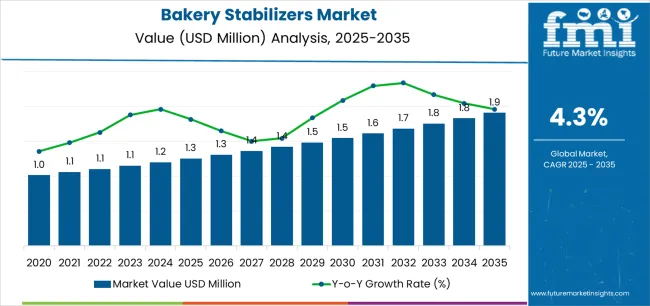
| Period | Primary Revenue Buckets | Share | Notes |
|---|---|---|---|
| Today | Emulsifiers (commercial bakery) | 48% | Traditional applications, texture enhancement |
| Thickening agents | 32% | Consistency control, moisture retention | |
| Hydrocolloid stabilizers | 15% | Specialty formulations, premium applications | |
| Multi-functional blends | 5% | Custom formulations, niche applications | |
| Future (3-5 yrs) | Advanced emulsifier systems | 42-45% | Clean-label formulations, natural alternatives |
| Smart stabilizer monitoring | 18-22% | Real-time quality tracking, process optimization | |
| Specialized texture systems | 16-19% | Premium texture enhancement, sensory improvement | |
| Custom formulation services | 12-15% | Application-specific, client-targeted solutions | |
| Digital process integration | 8-12% | Connected production, automated dosing | |
| Research & development services | 5-8% | New product development, regulatory support |
| Metric | Value |
|---|---|
| Market Value (2025) | USD 1.3 million |
| Market Forecast (2035) | USD 1.9 million |
| Growth Rate | 4.3% CAGR |
| Leading Technology | Emulsifier Systems |
| Primary Application | Artisan Bakery Segment |
The market demonstrates strong fundamentals with emulsifier systems capturing a dominant share through advanced functional capabilities and food application optimization. Artisan bakery applications drive primary demand, supported by increasing quality requirements and commercial facility capacity expansion. Geographic expansion remains concentrated in developed markets with established food infrastructure, while emerging economies show accelerating adoption rates driven by food industry modernization initiatives and rising quality standards.
Primary Classification: The market segments by stabilizer type into emulsifiers, thickeners, hydrocolloids, and blended formulations, representing the evolution from basic functional ingredients to sophisticated food solutions for comprehensive bakery optimization.
Secondary Classification: Application segmentation divides the market into artisan bakery, food manufacturing, industrial baking, and specialty applications, reflecting distinct requirements for functional effectiveness, quality standards, and production outcomes.
Tertiary Classification: End-use segmentation covers commercial bakeries, food manufacturers, retail chains, artisan producers, and research institutions, while distribution channels span direct sales, food ingredient distributors, and online platforms.
Regional Classification: Geographic distribution covers North America, Latin America, Western Europe, Eastern Europe, East Asia, South Asia Pacific, and Middle East & Africa, with developed markets leading adoption while emerging economies show accelerating growth patterns driven by food industry infrastructure expansion programs.
The segmentation structure reveals technology progression from standard stabilizer materials toward sophisticated functional systems with enhanced performance and quality capabilities, while application diversity spans from industrial facilities to artisan operations requiring precise formulation solutions.
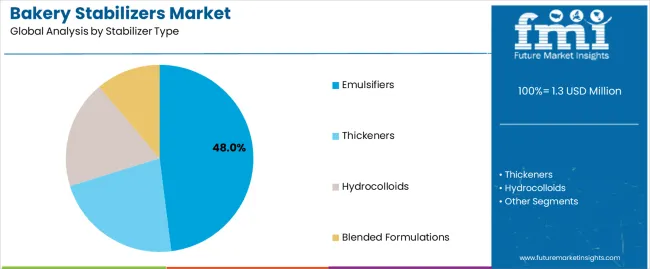
Market Position: Emulsifier systems command the leading position in the bakery stabilizers market with 48% market share through advanced functional features, including superior texture enhancement, stability characteristics, and food application optimization that enable bakery facilities to achieve optimal product outcomes across diverse commercial and artisan environments.
Value Drivers: The segment benefits from bakery facility preference for reliable functional systems that provide consistent texture performance, reduced processing time, and operational efficiency optimization without requiring significant infrastructure modifications. Advanced formulation features enable automated dosing control systems, quality monitoring, and integration with existing production equipment, where functional performance and food safety represent critical facility requirements.
Competitive Advantages: Emulsifier systems differentiate through proven functional reliability, consistent performance characteristics, and integration with automated food systems that enhance facility effectiveness while maintaining optimal safety standards suitable for diverse bakery and food applications.
Key market characteristics:
Thickener systems maintain a 32% market position in the bakery stabilizers market due to their consistency control properties and moisture retention advantages. These formulations appeal to facilities requiring reliable texture solutions with competitive performance profiles for specialized food applications. Market growth is driven by food quality expansion, emphasizing consistent texture solutions and operational effectiveness through optimized formulation designs.
Hydrocolloid systems capture 15% market share through specialized applications in premium bakery products, specialty food manufacturing, and advanced formulation requirements. These facilities demand high-performance stabilizer systems capable of handling demanding applications while providing effective functional capabilities and operational reliability.
Multi-functional blend formulations account for 5% market share through customized formulation requirements in specialized bakery applications, research facilities, and development operations requiring tailored formulations for specific functional outcomes.
Market Context: Artisan Bakery applications demonstrate the highest growth rate in the bakery stabilizers market with 5.2% CAGR due to widespread adoption of quality systems and increasing focus on product optimization, operational cost efficiency, and customer satisfaction applications that maximize product effectiveness while maintaining quality standards.
Appeal Factors: Artisan bakery operators prioritize system reliability, functional consistency, and integration with existing production infrastructure that enables coordinated operations across multiple product lines. The segment benefits from substantial food industry investment and modernization programs that emphasize the acquisition of advanced functional systems for product optimization and quality applications.
Growth Drivers: Food expansion programs incorporate artisan bakery stabilizer systems as standard ingredients for production operations, while premium market growth increases demand for functional capabilities that comply with quality standards and minimize formulation complexity.
Market Challenges: Varying product requirements and formulation protocol complexity may limit system standardization across different facilities or production scenarios.
Application dynamics include:
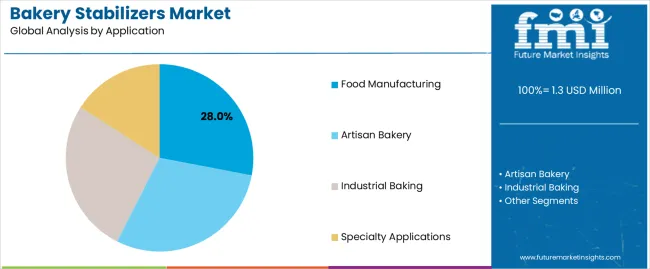
Food Manufacturing applications capture 28% market share through large-scale production requirements in industrial facilities, food processors, and manufacturing applications. These facilities demand effective functional systems capable of supporting consistent production while providing reliable performance access and operational efficiency capabilities.
Industrial Baking applications account for 22% market share, including large-scale operations, mass production, and commercial requirements requiring high-volume stabilizer capabilities for production optimization and cost management.
Market Context: Commercial Bakeries dominate the market with 5.1% CAGR, reflecting the primary demand source for bakery stabilizer technology in production applications and quality operations.
Business Model Advantages: Commercial bakeries provide direct market demand for advanced functional ingredients, driving product innovation and capacity expansion while maintaining quality control and regulatory compliance requirements.
Operational Benefits: Commercial bakery applications include product development, quality enhancement, and consistency assurance that drive consistent demand for stabilizer products while providing access to latest food technologies.
| Category | Factor | Impact | Why It Matters |
|---|---|---|---|
| Driver | Consumer demand for premium bakery products (texture, shelf-life, quality) | ★★★★★ | Growing consumer expectations require consistent product quality with proven performance and efficacy across food applications. |
| Driver | Food industry modernization & clean-label trends (natural ingredients, transparency) | ★★★★★ | Turns advanced functional systems from "optional" to "mandatory"; providers that offer clean-label solutions and transparency gain competitive advantage. |
| Driver | Artisan bakery growth & specialty products (craft baking, premium positioning) | ★★★★☆ | Artisan producers need high-quality, reliable systems; demand for specialty and premium functional solutions expanding addressable market. |
| Restraint | Raw material cost volatility & supply chain constraints (ingredient pricing) | ★★★★☆ | Smaller food producers defer purchases; increases price sensitivity and slows advanced ingredient adoption in cost-conscious markets. |
| Restraint | Alternative ingredient competition (enzyme solutions, protein-based systems) | ★★★☆☆ | Modern ingredient alternatives offer multifunctional benefits, potentially limiting traditional stabilizer adoption in innovation-forward facilities. |
| Trend | Smart production integration & monitoring (IoT, automated dosing) | ★★★★★ | Real-time dosing monitoring, quality tracking, and production analytics transform operations; connectivity and digital integration become core value propositions. |
| Trend | Personalized nutrition & customized formulations (health-focused products) | ★★★★☆ | Custom stabilizer formulations for specific dietary needs; specialized products and targeted functional capabilities drive competition toward personalization solutions. |
The bakery stabilizers market demonstrates varied regional dynamics with Growth Leaders including China (5.8% growth rate) and India (5.4% growth rate) driving expansion through food industry modernization initiatives and production capacity development. Steady Performers encompass Germany (4.9% growth rate), Brazil (4.5% growth rate), and developed regions, benefiting from established food industries and advanced ingredient adoption. Mature Markets feature United States (4.1% growth rate), United Kingdom (3.7% growth rate), and Japan (3.2% growth rate), where food technology advancement and regulatory standardization requirements support consistent growth patterns.
Regional synthesis reveals East Asian markets leading adoption through food expansion and infrastructure development, while North American countries maintain steady expansion supported by ingredient technology advancement and quality standardization requirements. European markets show moderate growth driven by food applications and quality integration trends.
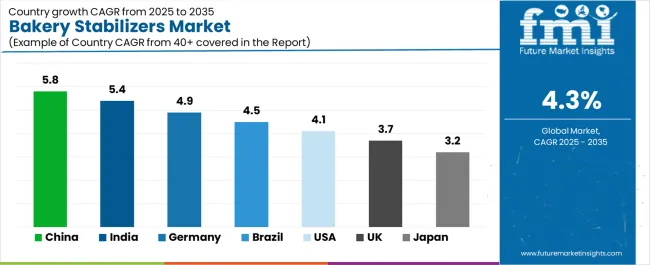
| Region/Country | 2025-2035 Growth | How to win | What to watch out |
|---|---|---|---|
| China | 5.8% | Focus on food modernization solutions | Regulatory changes; local competition |
| India | 5.4% | Lead with cost-effective systems | Import restrictions; price sensitivity |
| Germany | 4.9% | Provide premium quality products | Over-regulation; lengthy approvals |
| Brazil | 4.5% | Offer value-oriented models | Currency fluctuations; import duties |
| United States | 4.1% | Push clean-label integration | FDA compliance costs; market saturation |
| United Kingdom | 3.7% | Focus on quality standards | Brexit impacts; cost pressures |
| Japan | 3.2% | Emphasize precision systems | Mature market; slow adoption |
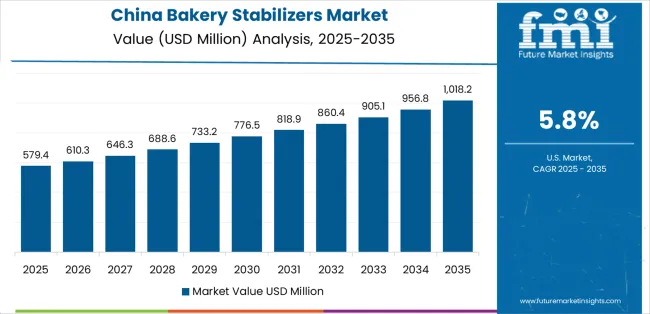
China establishes fastest market growth through aggressive food industry modernization programs and comprehensive production capacity development, integrating advanced bakery stabilizer systems as standard components in commercial facilities and industrial production installations. The country's 5.8% growth rate reflects government initiatives promoting food infrastructure and domestic production capabilities that mandate the use of advanced stabilizer systems in bakery and food facilities. Growth concentrates in major food hubs, including Beijing, Shanghai, and Guangzhou, where food technology development showcases integrated functional systems that appeal to food operators seeking advanced quality optimization capabilities and production applications.
Chinese manufacturers are developing cost-effective stabilizer solutions that combine domestic production advantages with advanced functional features, including automated dosing control and enhanced quality capabilities. Distribution channels through food ingredient suppliers and production service distributors expand market access, while government support for food modernization supports adoption across diverse bakery and food segments.
Strategic Market Indicators:
In Mumbai, Delhi, and Bangalore, food facilities and commercial bakeries are implementing advanced bakery stabilizer systems as standard ingredients for quality optimization and production applications, driven by increasing government food investment and infrastructure modernization programs that emphasize the importance of functional capabilities. The market holds a 5.4% growth rate, supported by government food initiatives and infrastructure development programs that promote advanced functional systems for bakery and food facilities. Indian operators are adopting stabilizer systems that provide consistent functional performance and quality features, particularly appealing in urban regions where product effectiveness and consumer satisfaction represent critical operational requirements.
Market expansion benefits from growing food capabilities and international technology partnerships that enable domestic production of advanced functional systems for bakery and food applications. Technology adoption follows patterns established in food ingredients, where reliability and performance drive procurement decisions and operational deployment.
Market Intelligence Brief:
Germany's advanced food technology market demonstrates sophisticated bakery stabilizer deployment with documented functional effectiveness in food applications and commercial facilities through integration with existing production systems and food infrastructure. The country leverages engineering expertise in food technology and quality systems integration to maintain a 4.9% growth rate. Food centers, including Bavaria, North Rhine-Westphalia, and Baden-Württemberg, showcase premium installations where functional systems integrate with comprehensive production platforms and facility management systems to optimize operations and functional effectiveness.
German manufacturers prioritize system precision and EU compliance in food ingredient development, creating demand for premium systems with advanced features, including facility monitoring integration and automated dosing systems. The market benefits from established food technology infrastructure and a willingness to invest in advanced functional technologies that provide long-term operational benefits and compliance with international food standards.
Market Intelligence Brief:
Brazil's market expansion benefits from diverse food demand, including infrastructure modernization in São Paulo and Rio de Janeiro, commercial facility upgrades, and government food programs that increasingly incorporate functional solutions for production applications. The country maintains a 4.5% growth rate, driven by rising food activity and increasing recognition of functional technology benefits, including precise dosing control and enhanced product effectiveness.
Market dynamics focus on cost-effective functional solutions that balance advanced production performance with affordability considerations important to Brazilian food operators. Growing food industrialization creates continued demand for modern functional systems in new facility infrastructure and production modernization projects.
Strategic Market Considerations:
United States establishes market leadership through comprehensive food programs and advanced industry infrastructure development, integrating bakery stabilizer systems across commercial and industrial applications. The country's 4.1% growth rate reflects established food industry relationships and mature functional technology adoption that supports widespread use of precision functional systems in bakery and food facilities. Growth concentrates in major food centers, including California, Illinois, and New York, where food technology showcases mature functional deployment that appeals to food operators seeking proven functional capabilities and operational efficiency applications.
American food producers leverage established distribution networks and comprehensive technical support capabilities, including validation programs and training support that create customer relationships and operational advantages. The market benefits from mature regulatory standards and food requirements that mandate functional system use while supporting technology advancement and operational optimization.
Market Intelligence Brief:
United Kingdom's food market demonstrates integrated bakery stabilizer deployment with documented functional effectiveness in commercial applications and food facilities through integration with existing production systems and food infrastructure. The country maintains a 3.7% growth rate, supported by food modernization programs and quality effectiveness requirements that promote advanced functional systems for food applications. Food facilities across England, Scotland, and Wales showcase systematic installations where functional systems integrate with comprehensive production platforms to optimize operations and quality outcomes.
UK food producers prioritize system reliability and quality standards compatibility in functional ingredient procurement, creating demand for validated systems with proven functional features, including production monitoring integration and automated dosing systems. The market benefits from established food infrastructure and quality validation requirements that support functional technology adoption and operational effectiveness.
Market Intelligence Brief:
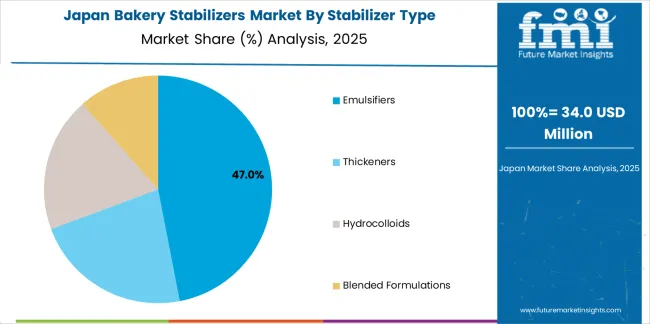
Japan's market growth benefits from precision food demand, including advanced production facilities in Tokyo and Osaka, food technology integration, and quality-focused programs that increasingly incorporate functional solutions for production applications. The country maintains a 3.2% growth rate, driven by food technology advancement and increasing recognition of precision functional benefits, including accurate dosing control and enhanced quality outcomes.
Market dynamics focus on high-precision functional solutions that meet Japanese quality standards and production effectiveness requirements important to food operators. Advanced food technology adoption creates continued demand for sophisticated functional systems in production facility infrastructure and quality modernization projects.
Strategic Market Considerations:
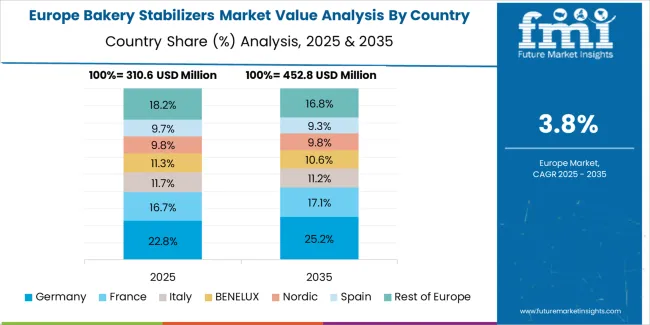
The European bakery stabilizers market is projected to grow from USD 389.2 million in 2025 to USD 578.4 million by 2035, registering a CAGR of 4.0% over the forecast period. Germany is expected to maintain its leadership position with a 41.8% market share in 2025, supported by its advanced food technology infrastructure and major production centers.
United Kingdom follows with a 22.1% share in 2025, driven by comprehensive quality programs and food technology development initiatives. France holds a 15.9% share through specialized food applications and regulatory compliance requirements. Italy commands a 12.4% share, while Spain accounts for 7.8% in 2025. The rest of Europe region is anticipated to gain momentum, expanding its collective share from 4.2% to 4.6% by 2035, attributed to increasing food adoption in Nordic countries and emerging production facilities implementing food modernization programs.
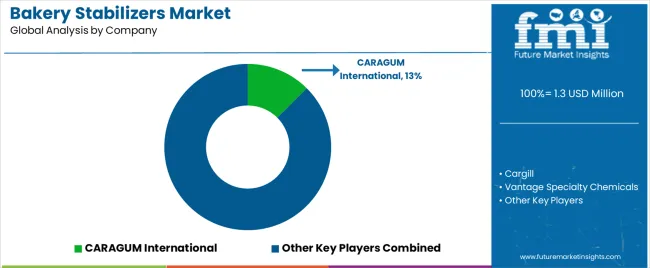
| Stakeholder | What they actually control | Typical strengths | Typical blind spots |
|---|---|---|---|
| Global platforms | Distribution reach, broad product catalogs, technical support networks | Wide availability, proven quality, multi-region support | Product refresh cycles; customer dependency on technical validation |
| Formulation innovators | R&D capabilities; advanced functional formulations; clean performance profiles | Latest formulations first; attractive ROI on functional effectiveness | Service density outside core regions; customization complexity |
| Regional specialists | Local compliance, fast delivery, nearby technical support | "Close to site" support; pragmatic pricing; local regulations | Formulation gaps; talent retention in technical support |
| Technical-focused ecosystems | Quality validation, technical training, regulatory support | Lowest technical risk; comprehensive support | Service costs if overpromised; technology obsolescence |
| Niche specialists | Specialized applications, custom formulations, research support | Win research/development applications; flexible configurations | Scalability limitations; narrow market focus |
| Item | Value |
|---|---|
| Quantitative Units | USD 1.3 million |
| Stabilizer Type | Emulsifiers, Thickeners, Hydrocolloids, Blended Formulations |
| Application | Artisan Bakery, Food Manufacturing, Industrial Baking, Specialty Applications |
| End Use | Commercial Bakeries, Food Manufacturers, Retail Chains, Artisan Producers, Research Institutions |
| Regions Covered | North America, Latin America, Western Europe, Eastern Europe, East Asia, South Asia Pacific, Middle East & Africa |
| Countries Covered | China, India, Germany, Brazil, United States, United Kingdom, Japan, Canada, France, Australia, and 30+ additional countries |
| Key Companies Profiled | CARAGUM International, Cargill, Incorporated, Vantage Specialty Chemicals, Tate & Lyle PLC, Holton Food Products Company, Ingredion Incorporated, Advanced Food Systems, Inc., Daxner GmbH, Palsgaard A/S, and IFF |
| Additional Attributes | Dollar sales by stabilizer type and application categories, regional adoption trends across East Asia, North America, and Western Europe, competitive landscape with food ingredient manufacturers and bakery suppliers, food operator preferences for functional effectiveness and quality reliability, integration with production platforms and quality monitoring systems, innovations in stabilizer formulations and functional enhancement, and development of advanced functional solutions with enhanced performance and food optimization capabilities. |
The global bakery stabilizers market is estimated to be valued at USD 1.3 million in 2025.
The market size for the bakery stabilizers market is projected to reach USD 1.9 million by 2035.
The bakery stabilizers market is expected to grow at a 4.3% CAGR between 2025 and 2035.
The key product types in bakery stabilizers market are emulsifiers, thickeners, hydrocolloids and blended formulations.
In terms of application, food manufacturing segment to command 28.0% share in the bakery stabilizers market in 2025.






Our Research Products

The "Full Research Suite" delivers actionable market intel, deep dives on markets or technologies, so clients act faster, cut risk, and unlock growth.

The Leaderboard benchmarks and ranks top vendors, classifying them as Established Leaders, Leading Challengers, or Disruptors & Challengers.

Locates where complements amplify value and substitutes erode it, forecasting net impact by horizon

We deliver granular, decision-grade intel: market sizing, 5-year forecasts, pricing, adoption, usage, revenue, and operational KPIs—plus competitor tracking, regulation, and value chains—across 60 countries broadly.

Spot the shifts before they hit your P&L. We track inflection points, adoption curves, pricing moves, and ecosystem plays to show where demand is heading, why it is changing, and what to do next across high-growth markets and disruptive tech

Real-time reads of user behavior. We track shifting priorities, perceptions of today’s and next-gen services, and provider experience, then pace how fast tech moves from trial to adoption, blending buyer, consumer, and channel inputs with social signals (#WhySwitch, #UX).

Partner with our analyst team to build a custom report designed around your business priorities. From analysing market trends to assessing competitors or crafting bespoke datasets, we tailor insights to your needs.
Supplier Intelligence
Discovery & Profiling
Capacity & Footprint
Performance & Risk
Compliance & Governance
Commercial Readiness
Who Supplies Whom
Scorecards & Shortlists
Playbooks & Docs
Category Intelligence
Definition & Scope
Demand & Use Cases
Cost Drivers
Market Structure
Supply Chain Map
Trade & Policy
Operating Norms
Deliverables
Buyer Intelligence
Account Basics
Spend & Scope
Procurement Model
Vendor Requirements
Terms & Policies
Entry Strategy
Pain Points & Triggers
Outputs
Pricing Analysis
Benchmarks
Trends
Should-Cost
Indexation
Landed Cost
Commercial Terms
Deliverables
Brand Analysis
Positioning & Value Prop
Share & Presence
Customer Evidence
Go-to-Market
Digital & Reputation
Compliance & Trust
KPIs & Gaps
Outputs
Full Research Suite comprises of:
Market outlook & trends analysis
Interviews & case studies
Strategic recommendations
Vendor profiles & capabilities analysis
5-year forecasts
8 regions and 60+ country-level data splits
Market segment data splits
12 months of continuous data updates
DELIVERED AS:
PDF EXCEL ONLINE
Bakery Ingredients Market Analysis - Size, Share, & Forecast Outlook 2025 to 2035
Bakery Packaging Machine Market Size and Share Forecast Outlook 2025 to 2035
Bakery Mixes Market Analysis - Size, Share, & Forecast Outlook 2025 to 2035
Bakery Product Market Analysis - Size, Share, and Forecast Outlook 2025 to 2035
Bakery Enzymes Market Analysis - Size, Share, and Forecast Outlook 2025 to 2035
Bakery Emulsions Market Analysis - Size, Share, and Forecast Outlook 2025 to 2035
Bakery Cases Market Analysis – Trends, Growth & Forecast 2025 to 2035
Bakery Processing Equipment Market Analysis by Product Type, End User, Application & Region: A Forecast for 2025 and 2035
Competitive Breakdown of Bakery Mixes Suppliers
Bakery Meal Market – Growth, Demand & Nutritional Applications
Bakery Fat Market – Demand, Innovations & Market Expansion
Bakery Flexible Packaging Market
Bakery Improvers Market
Bakery Conditioner Market
Stabilizers Market
United Kingdom Bakery Ingredients Market Outlook – Size, Demand & Forecast 2025–2035
United Kingdom Bakery Mixes Market Insights – Growth, Demand & Forecast 2025–2035
United States Bakery Ingredients Market Outlook – Demand, Size & Forecast 2025–2035
Food Stabilizers Market Size and Share Forecast Outlook 2025 to 2035
Beer Stabilizers Market Size and Share Forecast Outlook 2025 to 2035

Thank you!
You will receive an email from our Business Development Manager. Please be sure to check your SPAM/JUNK folder too.
Chat With
MaRIA